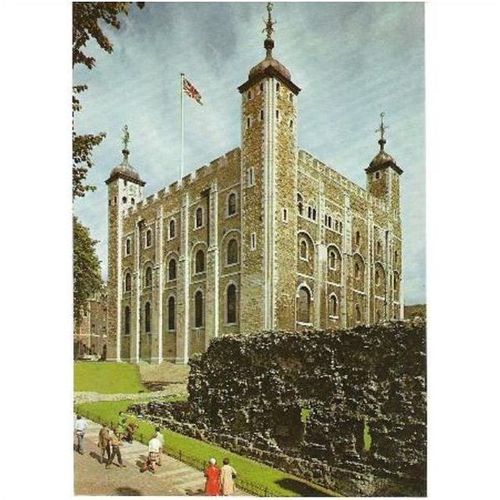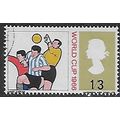London - Tower of London White Tower - offiicial government postcard 1973
- Condition : Used
- Dispatch : 2 Days
- Brand : None
- ID# : 114412390
- Quantity : 1 item
- Views : 161
- Location : United Kingdom

- Seller : justthebook (+1699)
- Barcode : None
- Start : Sun 21 Jul 2013 18:55:53 (EDT)
- Close : Run Until Sold
- Remain : Run Until Sold
Checks/Cheques
 for 1 item(s) edit
for 1 item(s) edit
Shipping Calculator
More Listings from This Seller view all
Seller's Description
- Postcard
- Picture / Image: The White Tower, Tower of London
- Publisher: HMSO Department of Environment 1973
- Postally used: no
- Stamp: n/a
- Postmark(s): n/a
- Sent to: n/a
- Notes / condition: excellent
Please ask if you need any other information and I will do the best I can to answer.
Image may be low res for illustrative purposes - if you need a higher definition image then please contact me and I may be able to send one.
------------------------------------------------
Postage & Packing:
UK (incl. IOM, CI & BFPO): 99p
Europe: £1.60
Rest of world (inc. USA etc): £2.75
No additional charges for more than one postcard. You can buy as many postcards from me as you like and you will just pay the fee above once. (If buying postcards with other things such as books, please contact or wait for invoice before paying).
Payment Methods:
UK - PayPal, Cheque (from UK bank) or postal order
Outside UK: PayPal ONLY (unless otherwise stated) please. NO non-UK currency checks or money orders (sorry).
NOTE: All postcards are sent in brand new stiffened envelopes which I have bought for the task. These are specially made to protect postcards and you may be able to re-use them. In addition there are other costs to sending so the above charge is not just for the stamp!
I will give a full refund if you are not fully satisfied with the postcard.
----------------------------------------------
Text from the free encyclopedia WIKIPEDIA may appear below to give a little background information (internal links may not work) :
*************
The White Tower is a central tower, the old keep, at the Tower of London. It was built by William the Conqueror during the late 11th century, and subsequently extended.
The castle which later became known as the Tower of London was begun by William the Conqueror in 1066. It began as a timber fortification enclosed by a palisade.[1] In the next decade work began on the White Tower, the great stone keep that still dominates the castle today. The precise date of the White Tower's foundation is unknown, and it is also uncertain how long building took. It is traditionally held that construction began in 1078. This is because the Textus Roffensis records that Gundulf, Bishop of Rochester, oversaw the building work under instruction from William the Conqueror.[2] Dendrochronological evidence suggests construction of the White Tower began in 1075–1079. The archaeology of the standing building suggests there was a pause in construction between 1080 and 1090–1093, although it is unknown why.[3] Gundulf did more than just oversee work and was a skilled architect. Rochester's castle and cathedral were rebuilt under his auspices.[2] As the main castle in England's capital,[nb 1] the Tower of London was an important royal building. The keep built by Gundulf bears testament to this as it was one of the largest in Christendom.[4]
The White Tower was multi-purpose. It was the castle's strongest point militarily yet provided accommodation fit for the king and his representatives. In Norman architecture the keep was a symbol of a lord's power. The White Tower was probably complete by 1100 at the latest, at which point it was used to imprison Ranulf Flambard, Bishop of Durham.[5] It was probably during Henry II's reign (1154–1189) that a forebuilding was added to the south side of the tower to provide extra defences to the entrance, but it has not survived.[6] Henry III's relations with his barons were uneasy, and in the 1220s and 1230s he enhanced the castle's defences and domestic buildings. Though the work he started may not have been finished within his lifetime, he extended the castle to the north and east, building a new stone wall to enclose the castle.[7] A timber gallery was added to the top of the White Tower, projecting beyond its walls to better defend the base of the tower.[8] Henry also undertook maintenance of the White Tower and it was during his reign that the tradition of whitewashing the building began. In March 1240 the Keeper of the Works at the Tower of London was ordered ""to have the Great Tower whitened both inside and out"". Later that year the king wrote to the Keeper, commanding that the White Tower's lead guttering should be extended with the effect that ""the wall of the tower ... newly whitened, may be in no danger of perishing or falling outwards through the trickling of the rain"".[7] Henry did not explain his order to whitewash the keep, but may have been influenced by contemporary fashion in Europe to paint prestigious buildings white. He also added decoration to the chapel in the keep, adding stained glass, statues, and paintings.[9]
Activity at the castle in the early 14th century declined relative to previous periods. Though the Tower of London was still occasionally used as a residence, by the 1320s the chapel in the White Tower was used to store records. This marked the beginning of the castle's diminishing role as a royal residence.[10] The records were briefly removed from the White Tower in 1360 to accommodate the captive French king, John II.[11] It may have been during the reign of Edward III (1327–1377) that a building abutting the south side of the White Tower was created. Built as storage, it may have been part of Edward's building programme at the Tower of London which saw its role as a military store come to the fore. The structure no longer survives, but is recorded on plans from 1597 and 1717.[10]
Richard II was imprisoned at the Tower of London and abdicated there in 1399; according to tradition, the event took place in the White Tower.[12] In the 1490s a new floor was added to the White Tower, creating extra storage.[13] Architecturally virtually no trace remains of the White Tower's forebuilding, although it appears in a manuscript drawing circa 1500 depicting the imprisonment of Charles, Duke of Orléans and was recorded in a plan of 1597.[14] It was demolished in 1674.[15] On 17 June that year, during the course of the demolition, bones belonging to two children were discovered beneath the stairs in the forebuilding. It was assumed that they belonged to the Princes in the Tower. The remains were re-interred in Westminster Abbey.[16] The story of the Princes in the Tower is one of the most infamous stories related to the castle. After the death of Edward IV his 12-year-old son was crowned as Edward V. Richard Duke of Gloucester was declared Lord Protector while the prince was too young to rule.[17] Edward was confined to the Tower of London along with his younger brother, Richard. The Duke of Gloucester was proclaimed King Richard III in July. The princes were last seen in public in June 1483;[15] the most likely reason for their disappearance is that they were murdered late in the summer of 1483.[15][17]
By the Tudor period, the science of fortification had change to deal with powerful cannons. The new designs, with low angled bastions, were not emulated at the Tower of London. All the same, some adaptations to use cannon were made; the changes included adding a timber platform to the top of the White Tower for cannon emplacements.[18] The weight of the guns damaged the roof so that it had to be reinforced.[19] The one documented use of these cannon was during Wyatt's rebellion in 1554 and they were ineffective.[18] The Office of Ordnance and Office of Armoury were head-quartered at the Tower of London until the 17th century. Their presence influenced activity at the castle as led to it becoming the country's most important military store. In the 1560s two armouries were created in the White Tower and by the reign of Elizabeth I (1558–1603) most of the gunpowder at the Tower was stored in the White Tower.[20] By the last quarter of the 16th century the castle was a tourist attraction with visitors allowed inside despite its use by the Offices of Ordnance and Armoury.[21] Its role in providing storage directly impacted on the White Tower's structure and posts were added to support the floors. In 1636 a hole was knocked through the White Tower's north wall to ease the movement of provisions. In 1639–1640 the White Tower's external appearance was changed, with much of its facing material replaced.[20]
In 1640 Charles I ordered that the Tower of London should be prepared for conflict. Platforms for cannons were built and 21 installed on top of the White Tower with three additional mortars. Despite the new defences the Parliamentarians captured the Tower of London without the cannon being used. In January 1642, Charles I attempted to arrest five Members of Parliament. When this failed he fled the city, and Parliament retaliated by removing Sir John Byron, the Lieutenant of the Tower. The Trained Bands had switched sides, and now supported Parliament; together with the London citizenry, they blockaded the Tower. With permission from the King, Byron relinquished control of the Tower. Parliament replaced Byron with a man of their own choosing, Sir John Conyers. By the time the English Civil War broke out in November 1642, the Tower of London was already in Parliament's control.[22] By 1657 the entire building apart from the chapel was being used to store gunpowder.[20] Storing both gunpowder and government records in the White Tower was not ideal, and there were repeated suggestions in 1620, 1718, and 1832 to move the gunpowder to a new location, although the proposals were unsuccessful.[11]
type=printed postcards
theme=topographical: british
sub-theme=england
county/ country=london
number of items=single
period=1945 - present
postage condition=unposted
Listing Information
| Listing Type | Gallery Listing |
| Listing ID# | 114412390 |
| Start Time | Sun 21 Jul 2013 18:55:53 (EDT) |
| Close Time | Run Until Sold |
| Starting Bid | Fixed Price (no bidding) |
| Item Condition | Used |
| Bids | 0 |
| Views | 161 |
| Dispatch Time | 2 Days |
| Quantity | 1 |
| Location | United Kingdom |
| Auto Extend | No |














